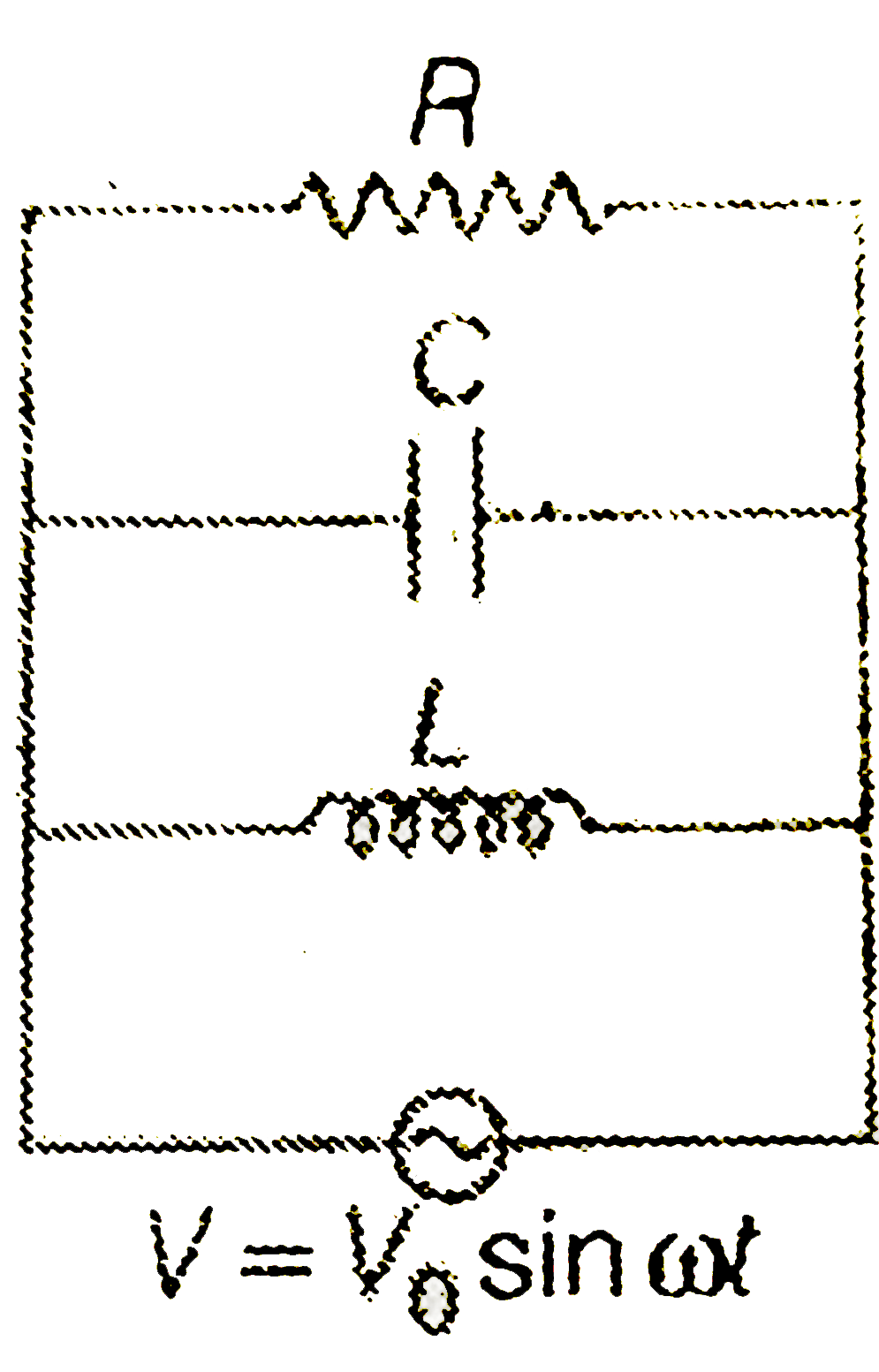A series RLC circuit is driven by a generator at frequency 1000Hz. The inductance is 90.0 mH, capacitance is 0.5μF and the phase constant has magnitude of 60∘ (Takeπ2=10)
Here current leads the voltage in phase
Here voltage leads the current in phase
Resistance of circuit is 80π√3Ω
At resonance √23×104rad/sec
The correct Answer is:B, C, D
To solve the problem, we need to analyze the given series RLC circuit with the following parameters:
- Frequency, f=1000Hz
- Inductance, L=90.0mH=90×10−3H
- Capacitance, C=0.5μF=0.5×10−6F
- Phase constant, ϕ=60∘
We need to determine whether the current leads the voltage or vice versa, and also find the resistance and the resonant frequency.
Step 1: Calculate the inductive reactance (XL)
The inductive reactance is given by the formula:
XL=2πfL
Substituting the values:
XL=2π(1000)(90×10−3)=180πΩ
Step 2: Calculate the capacitive reactance (XC)
The capacitive reactance is given by the formula:
XC=12πfC
Substituting the values:
XC=12π(1000)(0.5×10−6)=1π×10−3=1000πΩ
Step 3: Compare XL and XC
Now we compare XL and XC:
- XL=180π≈565.2Ω
- XC=1000π≈318.47Ω
Since XL>XC, the circuit is inductive, which means that the voltage leads the current.
Step 4: Calculate the resistance (R)
Using the phase angle relation:
tan(ϕ)=XL−XCR
We know ϕ=60∘, thus:
tan(60∘)=√3
Substituting the values:
√3=180π−1000πR
Rearranging gives:
R=180π−1000π√3
Substituting π2=10:
R=1800−1000√3⋅π=800√3⋅π
This simplifies to:
R=80π√3Ω
Step 5: Calculate the resonant frequency (ω)
At resonance, the formula for angular frequency is:
ω=1√LC
Substituting the values:
ω=1√(90×10−3)(0.5×10−6)=1√45×10−9=1043√2
Thus, we have:
ω=√23×104rad/s
Summary of Results
- Current leads the voltage: No, Voltage leads the current.
- Resistance R: 80π√3Ω.
- Resonant frequency ω: √23×104rad/s.
- Inductance, L=90.0mH=90×10−3H
- Capacitance, C=0.5μF=0.5×10−6F
- Phase constant, ϕ=60∘
The inductive reactance is given by the formula:
XL=2πfL
Substituting the values:
XL=2π(1000)(90×10−3)=180πΩ
The capacitive reactance is given by the formula:
XC=12πfC
Substituting the values:
XC=12π(1000)(0.5×10−6)=1π×10−3=1000πΩ
Now we compare XL and XC:
- XL=180π≈565.2Ω
- XC=1000π≈318.47Ω
Using the phase angle relation:
tan(ϕ)=XL−XCR
We know ϕ=60∘, thus:
tan(60∘)=√3
Substituting the values:
√3=180π−1000πR
Rearranging gives:
R=180π−1000π√3
Substituting π2=10:
R=1800−1000√3⋅π=800√3⋅π
This simplifies to:
R=80π√3Ω
At resonance, the formula for angular frequency is:
ω=1√LC
Substituting the values:
ω=1√(90×10−3)(0.5×10−6)=1√45×10−9=1043√2
Thus, we have:
ω=√23×104rad/s
- Current leads the voltage: No, Voltage leads the current.
- Resistance R: 80π√3Ω.
- Resonant frequency ω: √23×104rad/s.
Similar Questions
Find the resonant frequency of a series circuit consist of an inductance 200 μH, a capacitance of 0.0005μF and a resistance of 10 Ω.
View SolutionA series circuit consists of a resistance inductance and capacitance.The applied voltage and the current at any instant are given by E=141.4cos(5000t−100)
and I=5cos(5000t−3700)
The inductance is 0.01 henry.Calculate the value of capacitance and resistance.View Solution
Knowledge Check
- Question 1 - Select One
The resonant frequency of a series LCR circuit with L=2.0H,C=32μF and R=10Ω is
A20 HzB30 HzC40 HzD50 Hz - Question 2 - Select One
A simple harmonic oscillator has a frequency of 2.5 Hz and an amplitude of 0.05m. What is the period of the oscillations?
A0.4sB0.2sC8sD20s
The frequency for which a 5.0 muF capacitor has a reactance of 1000Ω is given by
View SolutionAn oscillator circuit consists of an inductance of 0.5mH and a capacitor of 20μF. The resonant frequency of the circuit is nearly
View SolutionA series circuit has an impendence of 50.0Ω and a power factor of 0.63 to 60Hz. The voltage lags the current. To raise the power factor of the circuit
 View Solution
View SolutionA coil of inductance L=5/8H and of resistance R=62.8(Ω) is connected to the mains alternating voltage of frequency 50 Hz. What can be the capacitance of the capacitor (∈(μ)F) connected in series with the coil if the power dissipated has to remain unchanged? Take (π)2=10.
View Solution(a) What is the reactance of a 2.00H inductor at a frequency of 50.0Hz?
(b) What is the inductance of an inductor whose reactance is 2.00Ω at 50.0Hz?
(c) What is the reactance of a 2.00μF capacitor at a frequency of 50.0Hz?
(d) What is the capacitance of a capacitor whose reactance is 2.00Ω at 50.0Hz?View SolutionA capacitor of capacitance 25μF is charged to 300V. It is then connected across a 10mH inductor. The resistance in the circuit is negligible.
a. Find the frequency of oscillation of the circuit.
b. Find the potential difference across capacitor and magnitude of circuit current 1.2ms after the inductor and capacitor are connected.
c. Find the magnetic energy and electric energy at t=0 and t=1.2ms.View Solution

